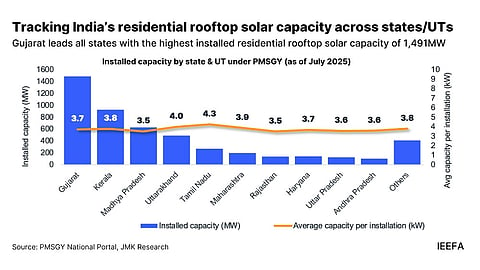

PMSGMBY added 4.9 GW rooftop solar capacity in over a year, boosting residential adoption sharply, according to a new IEEFA & JMK report
Only 13.1% of target installations and 14.1% of subsidies were completed till July 2025
State facilitation and standardized kits can accelerate future installations
The Pradhan Mantri Surya Ghar Muft Bijli Yojana (PMSGMBY) has accelerated India’s residential rooftop solar capacity by 4.9 GW within a year of its launch, according to a new Institute for Energy Economics and Financial Analysis (IEEFA) and JMK Research & Analytics report.
However, analysts caution that slow subsidy disbursal and partial target achievement could challenge the government’s 30 GW goal for FY2027 (see India Eyeing 30 GW Rooftop Solar Capacity With New Scheme).
Traditionally focused on the commercial and industrial (C&I) segment, PMSGMBY boosted India’s residential rooftop solar market with the promise of subsidies out of its INR 750 billion outlay.
It generated interest enough to register a nearly fourfold increase in applications between March 2024 and July 2025. Cumulatively, more than 5.79 million applications were submitted for residential rooftop solar installations till the end of July 2025.
Yet, only 13.1% of the 10 million installation target was achieved, and only 14.1% of the allocated subsidies were released till July this year, exceeding INR 98.2 billion ($1.05 billion).
“Given this context, achieving the FY2027 target of 30GW capacity continues to be seen as a considerable challenge,” according to the analysts.
To turn more applications into real solar installations, state and district facilitation teams should help households apply for and claim subsidies, recommend the authors. Awareness campaigns and outreach programs can also educate people about adopting solar. Additionally, the government can look at standardized plug-and-play pre-assembled kits to boost installations.
The long-term success of PMSGMBY depends not just on providing subsidies, but also on creating smooth digital processes, standard products, and strong customer support, stress the authors.
In terms of installed capacity, Gujarat leads with the largest share of 1.49 GW residential rooftop solar capacity under the scheme, followed by Maharashtra, Uttar Pradesh, Kerala, and Rajasthan. These states represent close to 77.2% of the total installed capacity.
“Establishing clear, time-bound rooftop solar capacity targets at the state level is essential for creating a coherent vision and ensuring effective policy execution,” recommends Director, IEEFA - South Asia, and a contributing author to the report, Vibhuti Garg.
The complete report titled Advancing residential rooftop solar adoption in India under PM Surya Ghar Yojana is available on IEEFA’s website for free download.
